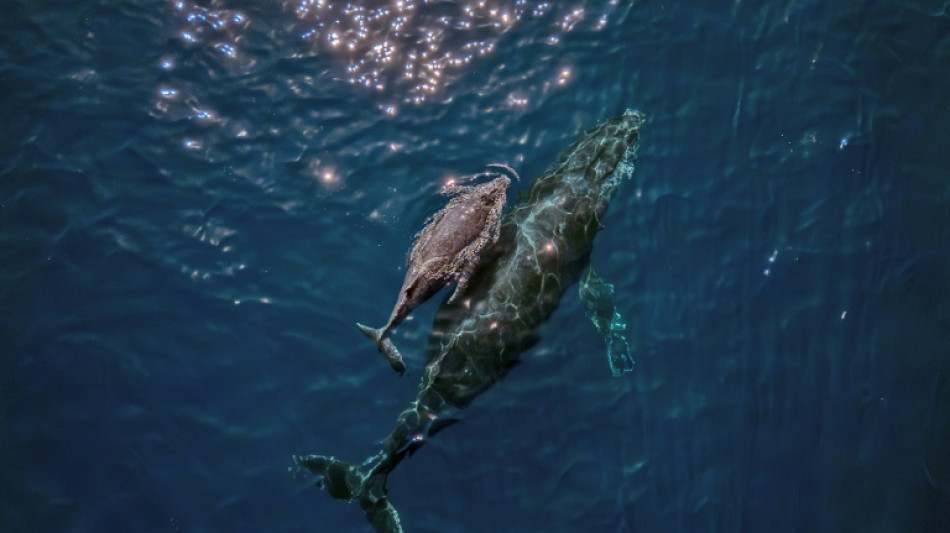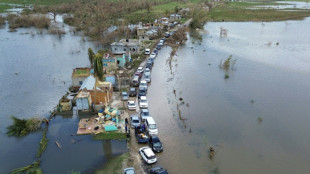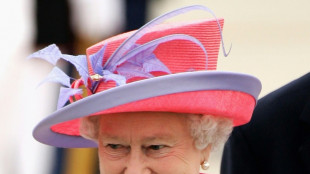
-
 Scandic Trust Group strengthens sales network with First Idea Consultant
Scandic Trust Group strengthens sales network with First Idea Consultant
-
'Roy of the Rovers story' -- Farrell handed Ireland debut for Japan Test

-
 Stones backs Man City team-mate Foden to pose England dilemma for Tuchel
Stones backs Man City team-mate Foden to pose England dilemma for Tuchel
-
Djokovic to face Alcaraz in ATP Finals groups

-
 Facing climate 'overshoot', world heads into risky territory
Facing climate 'overshoot', world heads into risky territory
-
Springbok skipper Kolisi to play 100th Test against France

-
 Typhoon Kalmaegi hits Vietnam after killing 140 in Philippines
Typhoon Kalmaegi hits Vietnam after killing 140 in Philippines
-
Bank of England leaves rate unchanged before UK budget

-
 Germany recall Sane, hand El Mala debut for World Cup qualifers
Germany recall Sane, hand El Mala debut for World Cup qualifers
-
India thump Australia to take 2-1 lead in T20 series

-
 Cameroon's Biya, world's oldest president, sworn in for 8th term
Cameroon's Biya, world's oldest president, sworn in for 8th term
-
Flick holding firm on Barca high line despite defensive woes

-
 Battered US businesses eye improved China trade at Shanghai expo
Battered US businesses eye improved China trade at Shanghai expo
-
France opt for Le Garrec as Dupont replacement for 'best team ever' South Africa

-
 Drugmaker AstraZeneca profit jumps as US business grows
Drugmaker AstraZeneca profit jumps as US business grows
-
'Vibe coding' named word of the year by Collins dictionary

-
 Vietnam evacuates thousands from coast ahead of Typhoon Kalmaegi
Vietnam evacuates thousands from coast ahead of Typhoon Kalmaegi
-
European stocks fall after gains in Asia, US

-
 MotoGP legend Agostini admires Marc Marquez's 'desire to win'
MotoGP legend Agostini admires Marc Marquez's 'desire to win'
-
Nepal searches for avalanche victims

-
 Hezbollah rejects any negotiations between Lebanon and Israel
Hezbollah rejects any negotiations between Lebanon and Israel
-
Chapman blitz leads Black Caps to tight T20 victory over West Indies

-
 France urges EU to sanction Shein platform
France urges EU to sanction Shein platform
-
France opt for Le Garrec as Dupont replacement for South Africa Test

-
 Turmoil in tiaras at Miss Universe pageant in Thailand
Turmoil in tiaras at Miss Universe pageant in Thailand
-
Probe into Thales defence group looking at Indonesian contract

-
 US to cancel flights as longest govt shutdown drags on
US to cancel flights as longest govt shutdown drags on
-
Home in Nigeria, ex-refugees find themselves in a war zone

-
 Doncic's Lakers hold off Wembanyama's Spurs, Blazers silence Thunder
Doncic's Lakers hold off Wembanyama's Spurs, Blazers silence Thunder
-
For Turkey's LGBTQ community, draft law sparks existential alarm

-
 Musk's $1 trillion pay package to face Tesla shareholder vote
Musk's $1 trillion pay package to face Tesla shareholder vote
-
Tonga rugby league star out of intensive care after seizure

-
 Argentine ex-president Kirchner goes on trial in new corruption case
Argentine ex-president Kirchner goes on trial in new corruption case
-
Dams, housing, pensions: Franco disinformation flourishes online

-
 Endo returns as Japan look to build on Brazil win
Endo returns as Japan look to build on Brazil win
-
Franco captivates young Spaniards 50 years after death

-
 German steel industry girds for uncertain future
German steel industry girds for uncertain future
-
IPL champions Bengaluru could be sold for 'as much as $2 billion'

-
 Budget impasse threatens Belgium's ruling coalition
Budget impasse threatens Belgium's ruling coalition
-
New Zealand ex-top cop admits to having material showing child abuse, bestiality

-
 BoE set for finely balanced pre-budget rate call
BoE set for finely balanced pre-budget rate call
-
Australian kingpin obtains shorter sentence over drug charge

-
 Weatherald's unenviable Ashes task: fill giant hole at top left by Warner
Weatherald's unenviable Ashes task: fill giant hole at top left by Warner
-
Ovechkin first to score 900 NHL goals as Capitals beat Blues

-
 On Mexico City's streets, vendors fight to make it to World Cup
On Mexico City's streets, vendors fight to make it to World Cup
-
Asian markets bounce from selloff as US jobs beat forecasts

-
 Philippine death toll tops 140 as typhoon heads towards Vietnam
Philippine death toll tops 140 as typhoon heads towards Vietnam
-
Kyrgios targets 'miracle' Australian Open return after knee improves

-
 'AI president': Trump deepfakes glorify himself, trash rivals
'AI president': Trump deepfakes glorify himself, trash rivals
-
Belgium probes drone sightings after flights halted overnight


Back from the brink: the migratory species on the road to recovery
While a landmark new report on the world's threatened migratory species is a catalogue of decline and destruction, the handful of animals staging a comeback shows improvement is possible -- if humans change their ways.
From the majestic humpback whale launching into the air from the waves, or the thousands of snub-nosed saiga antelope fanning across the steppes of Central Asia. These sights would have been barely possible without the concerted conservation efforts that have helped these species rebuild populations.
The State of the World's Migratory Species assessment, published Monday, found that animals, fish, birds and reptiles listed for protection under the UN Convention on the Conservation of Migratory Species of Wild Animals (CMS) were seeing declines across the world.
Around 70 of the threatened species saw their conservation status worsen between 1988 and 2020.
But 14 have shown an improvement, it found. Here are some of those recovering species:
- Humpback whales -
For hundreds of years, whalers from across the planet hunted humpback whales for their oil, meat, and baleen -- their feeding filtration system.
According to the International Union for Conservation of Nature (IUCN) they were targeted by early hunters in their wintering areas near the West Indies and Cape Verde, then near their summer feeding grounds from the 1860s, especially off Iceland and Norway. In the Pacific they were hunted particularly by Japanese whalers.
By 1986, the IUCN had listed the species as globally endangered.
International restrictions on commercial whaling allowed the humpback whale population to rebound and today, more than 80,000 mature individuals navigate throughout the world's oceans.
While some subpopulations have now recovered more than 90 percent of their pre-whaling numbers, the CMS report said other smaller groupings like the humpbacks in the Arabian Sea, were still endangered.
Continuing threats include from fishing gear, underwater noise pollution, and collisions with ships.
- Vicuna -
Vicunas, a llama-like creature that roams wild in parts of Argentina, Bolivia, Ecuador, Chile, Peru, is one of the few undomesticated animals sought for its wool.
Illegal poaching brought vicunas to the brink of extinction.
Numbers are now increasing thanks to legal protection from hunting, an international trade ban and education initiatives and the vicuna conservation status has changed from near threatened to least concern.
But threats from poaching for the illegal market, habitat encroachment and climate change remain.
- Lesser Kestrel -
The lessekestrel was once one of the most abundant small, migratory birds of prey that could befound from Spain to southern Russia to China.
The use of pesticides, especially DDT from the 1940s to 1970s, poisoned the birds directly and caused a drastic reduction in prey.
Habitat loss from urbanisation and agricultural intensification also caused severe population declines throughout Europe.
Since the 1980s, targeted conservation efforts -- like providing artificial nests, restoring breeding colonies, and releasing captive-bred birds into the wild -- have helped boost populations in southwestern Europe.
- Saiga Antelope -
National and international conservation efforts helped bring the Saiga Antelope back from the brink of extinction.
The revival of Kazakhstan's steppe and wetland habitats, projects to reintroduce native species and efforts to work with local communities to address overexploitation all played a role in their recovery.
Its population in Kazakhstan rebounded from a perilous low of 50,000 individuals in 2006, to over 1.3 million in 2022.
The species has now partially resumed migration into Uzbekistan.
- Black-Faced Spoonbill -
The black-faced spoonbill is a migratory seabird found in North and South Korea, China, Russia, Japan, Vietnam, Cambodia, Thailand, and the Philippines.
These white wading birds travel along a restricted migration route for breeding and wintering.
Their habitat has come under threat from growing human populations and agricultural and industrial development, while the birds face pesticide pollution, hunting, and the collection of eggs from nesting sites.
But legal protections, the designation of breeding sites as seabird sanctuaries and wetland restoration projects have all helped to improve the species' status from critically endangered to endangered.
A.Suleiman--SF-PST




